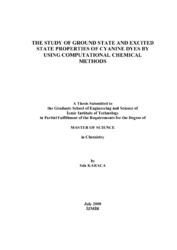Please use this identifier to cite or link to this item:
https://hdl.handle.net/11147/3916Full metadata record
| DC Field | Value | Language |
|---|---|---|
| dc.contributor.advisor | Elmacı Irmak, Nuran | en |
| dc.contributor.author | Karaca, Sıla | - |
| dc.date.accessioned | 2014-07-22T13:52:40Z | - |
| dc.date.available | 2014-07-22T13:52:40Z | - |
| dc.date.issued | 2008 | en |
| dc.identifier.uri | http://hdl.handle.net/11147/3916 | - |
| dc.description | Thesis (Master)--İzmir Institute of Technology, Chemistry, İzmir, 2008 | en |
| dc.description | Includes bibliographical references (leaves: 62-67) | en |
| dc.description | Text in English; Abstract: Turkish and English | en |
| dc.description | xv, 67 leaves | en |
| dc.description.abstract | The 5,5.,6,6.-tetrachloro-1,1.,3,3.-tetraethyl-benzimidazolo carbocyanine (TTBC) iodide, abbreviated CBIC2(3) or JC-1, is used for the molecular probe especially as measuring mitochondrial membrane potential and allows to visualize mitochondria, apoptosis or not.The behaviors of the TTBC at the ground and excited states have been investigated by using quantum chemical methods. DFT/6-31G** levels of theory calculations have been carried out for the optimization and the frequencies with B3LYP and PBEPBE functionals for the ground state structure. TDDFT/6-31G** and CIS/6-31G** methods have been used for the excited state properties. In addition to those, solvation calculations were performed with CPCM and IEFPCM.The effects of the functional groups, length of the conjugated chain, and alkyl groups on TTBC have been analyzed. There is no significant effect of functional groups either as donor or acceptor on the optimum structure. Only the alkyl groups change the planarity of the molecule. TTBC has a very rigid geometry. But it is possible to tune up max with NH2 and butyl/propyl and increasing polymethine chain length.To explain the shoulder on the fluorescence spectrum, the PES section was obtained. The fluorescence property of TTBC was compared with the experimental data. Although perpendicular structure is favorable in the first excited state, there is no significant difference in dipoles. The twisted charge transfer state is absent in this dye based on these calculations. The solvent effect on TTBC in different solvents was investigated. The solvation calculations show that, max values are independent of the polarity of the solvents as seen experimentally. | en |
| dc.language.iso | en | en_US |
| dc.publisher | Izmir Institute of Technology | en_US |
| dc.rights | info:eu-repo/semantics/openAccess | en_US |
| dc.subject.lcc | TP918.C9 K181 2008 | en |
| dc.subject.lcsh | Dyes and dyeing--Chemistry | en |
| dc.subject.lcsh | Cyanines | en |
| dc.title | The study of ground state and excited state properties of cyanine dyes by using computational chemical methods | en_US |
| dc.type | Master Thesis | en_US |
| dc.institutionauthor | Karaca, Sıla | - |
| dc.department | Thesis (Master)--İzmir Institute of Technology, Chemistry | en_US |
| dc.relation.publicationcategory | Tez | en_US |
| item.languageiso639-1 | en | - |
| item.fulltext | With Fulltext | - |
| item.openairecristype | http://purl.org/coar/resource_type/c_18cf | - |
| item.openairetype | Master Thesis | - |
| item.grantfulltext | open | - |
| item.cerifentitytype | Publications | - |
| Appears in Collections: | Master Degree / Yüksek Lisans Tezleri | |
Files in This Item:
| File | Description | Size | Format | |
|---|---|---|---|---|
| T000741.pdf | MasterThesis | 1.42 MB | Adobe PDF |  View/Open |
CORE Recommender
Page view(s)
100
checked on Jul 22, 2024
Download(s)
78
checked on Jul 22, 2024
Google ScholarTM
Check
Items in GCRIS Repository are protected by copyright, with all rights reserved, unless otherwise indicated.